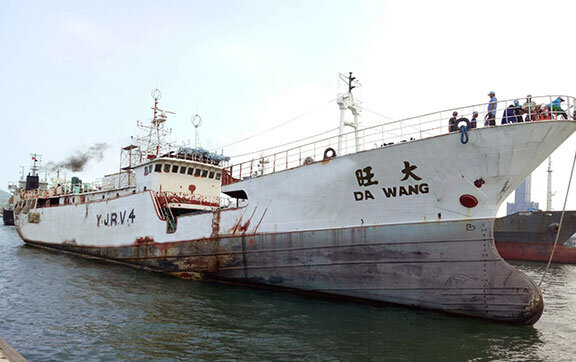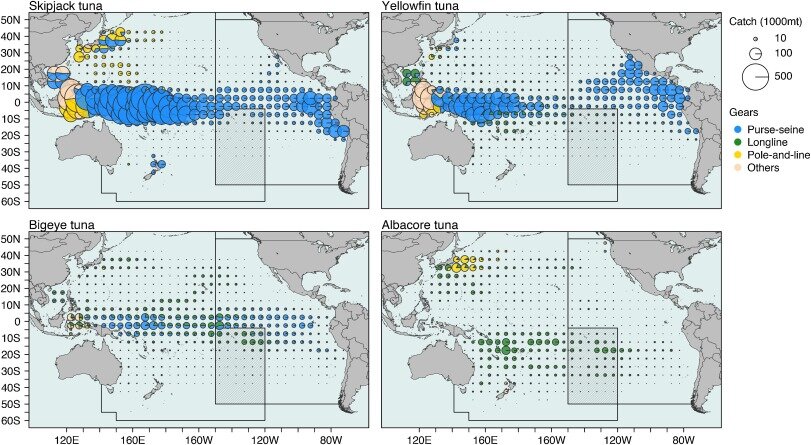I’m way to low in the trophic and brain capacity scale as to have a valid opinion on the accuracy of the conclusions, but I liked what I read and how they angled the premises of the paper.
I just quote parts of it, yet my usual recommendation is to read the original.
The abstract sets the paper in motion:
Abstract
Global food demand is rising, and serious questions remain about whether supply can increase sustainably1. Land-based expansion is possible but may exacerbate climate change and biodiversity loss, and compromise the delivery of other ecosystem services. As food from the sea represents only 17% of the current production of edible meat, we ask how much food we can expect the ocean to sustainably produce by 2050. Here we examine the main food-producing sectors in the ocean—wild fisheries, finfish mariculture and bivalve mariculture—to estimate ‘sustainable supply curves’ that account for ecological, economic, regulatory and technological constraints. We overlay these supply curves with demand scenarios to estimate future seafood production. We find that under our estimated demand shifts and supply scenarios (which account for policy reform and technology improvements), edible food from the sea could increase by 21–44 million tonnes by 2050, a 36–74% increase compared to current yields. This represents 12–25% of the estimated increase in all meat needed to feed 9.8 billion people by 2050. Increases in all three sectors are likely but are most pronounced for mariculture. Whether these production potentials are realized sustainably will depend on factors such as policy reforms, technological innovation and the extent of future shifts in demand.
The main part describes well the challenges and the approach
Main
Human population growth, rising incomes and preference shifts will considerably increase global demand for nutritious food in the coming decades. Malnutrition and hunger still plague many countries and projections of population and income by 2050 suggest a future need for more than 500 megatonnes (Mt) of meat per year for human consumption. Scaling up the production of land-derived food crops is challenging, because of declining yield rates and competition for scarce land and water resources. Land-derived seafood (freshwater aquaculture and inland capture fisheries; we use seafood to denote any aquatic food resource, and food from the sea for marine resources specifically) has an important role in food security and global supply, but its expansion is also constrained. Similar to other land-based production, the expansion of land-based aquaculture has resulted in substantial environmental externalities that affect water, soil, biodiversity and climate, and which compromise the ability of the environment to produce food.
Despite the importance of terrestrial aquaculture in seafood production (Supplementary Fig. 3), many countries—notably China, the largest inland-aquaculture producer—have restricted the use of land and public waters for this purpose, which constrains expansion Although inland capture fisheries are important for food security, their contribution to total global seafood production is limited (Supplementary Table 1) and expansion is hampered by ecosystem constraints. Thus, to meet future needs (and recognizing that land-based sources of fish and other foods are also part of the solution), we ask whether the sustainable production of food from the sea has an important role in future supply.
Food from the sea is produced from wild fisheries and species farmed in the ocean (mariculture), and currently accounts for 17% of the global production of edible meat (Supplementary Information section 1.1, Supplementary Tables 1–3). In addition to protein, food from the sea contains bioavailable micronutrients and essential fatty acids that are not easily found in land-based foods, and is thus uniquely poised to contribute to global food and nutrition security.
Widely publicized reports about climate change, overfishing, pollution and unsustainable mariculture give the impression that sustainably increasing the supply of food from the sea is impossible. On the other hand, unsustainable practices, regulatory barriers, perverse incentives and other constraints may be limiting seafood production, and shifts in policies and practices could support both food provisioning and conservation goals.
In this study, we investigate the potential of expanding the economically and environmentally sustainable production of food from the sea for meeting global food demand in 2050. We do so by estimating the extent to which food from the sea could plausibly increase under a range of scenarios, including demand scenarios under which land-based fish act as market substitutes.
The future contribution of food from the sea to global food supply will depend on a range of ecological, economic, policy and technological factors. Estimates based solely on ecological capacity are useful, but do not capture the responses of producers to incentives and do not account for changes in demand, input costs or technology.
To account for these realities, we construct global supply curves of food from the sea that explicitly account for economic feasibility and feed constraints. We first derive the conceptual pathways through which food could be increased in wild fisheries and in mariculture sectors. We then empirically derive the magnitudes of these pathways to estimate the sustainable supply of food from each seafood sector at any given price21. Finally, we match these supply curves with future demand scenarios to estimate the likely future production of sustainable seafood at the global level.
I particularly like the four pathways they see as to sustainably increase food from the sea:
improving the management of wild fisheries;
implementing policy reforms of mariculture;
advancing feed technologies for fed mariculture; and
shifting demand, which affects the quantity supplied from all three production sectors.
The analysis from these bases is quite deep and interesting, I recommend you follow it, otherwise here are the conclusions
Conclusions
Global food demand is rising, and expanding land-based production is fraught with environmental and health concerns. Because seafood is nutritionally diverse and avoids or lessens many of the environmental burdens of terrestrial food production, it is uniquely positioned to contribute to both food provision and future global food and nutrition security. Our estimated sustainable supply curves of food from the sea suggest substantial possibilities for future expansion in both wild fisheries and mariculture.
The potential for increased global production from wild fisheries hinges on maintaining fish populations near their most-productive levels. For underutilized stocks, this will require expanding existing markets. For overfished stocks, this will require adopting or improving management practices that prevent overfishing and allow depleted stocks to rebuild.
Effective management practices commonly involve setting and enforcing science-based limits on catch or fishing effort, but appropriate interventions will depend on the biological, socioeconomic, cultural and governance contexts of individual fisheries.
Effective management will be further challenged by climate change, species composition changes in marine ecosystems and illegal fishing. Directing resources away from subsidies that enhance fishing capacity towards building institutional and technical capacity for fisheries research, management and enforcement will help to meet these challenges.
Increased mariculture production will require management practices and policies that allow for environmentally sustainable expansion, while balancing the associated trade-offs to the greatest extent possible; this principle underpins the entire analysis. We find that substantial expansion is realistic, given the costs of production and the likely future increase in demand.
We have identified a variety of ways that sustainable supply curves can shift outward. These shifts interact with future demand to determine the plausible future equilibrium quantity of food produced from the sea. We find that although supply could increase to more than six times the current level (primarily via expanded mariculture), the demand shift required to engage this level of supply is unlikely. Under more realistic demand scenarios and appropriate reforms of the supply, we find that food from the sea could increase in all three sectors (wild fisheries, finfish mariculture and bivalve mariculture) to a total of 80–103 Mt of food in 2050 versus 59 Mt at present (in live-weight equivalents, 159–227 Mt compared to 102 Mt at present).
When combined with projected inland production, this represents an 18–44% per decade increase in live-weight production, which is somewhat higher than the 14% increase that the Organisation for Economic Co-operation and Development (OECD) and the FAO project for total fish production during the next decade.
Under some scenarios, future production could represent a disproportionate fraction of the estimated total increase in global food production that will be required to feed 9.8 billion people by 2050. Substantial growth in mariculture will rely partly on public perceptions. Although there is some evidence of a negative public perception of aquaculture, it is highly variable by region and by context, and certifications and the provision of other information can help to alleviate concerns and expand demand.
These global projections will not have uniform implications around the world. For example, improved policies that shift the supply curve outward will decrease prices, but income-induced demand shifts will increase prices. Both effects increase production but have vastly different consequences for low-income consumers.
Bivalves may contribute substantially to food security by providing relatively low-cost and thus accessible food, because they have a high production potential at low costs compared to finfish production (Fig. 3). If all seafood is perfectly substitutable, bivalves could contribute 43% and 34% of future aquatic food under future and extreme demand scenarios, respectively (Supplementary Fig. 3)—which suggests potential large increases in production, provided demand is high enough.
Trade also has an important role in distributing seafood from high-production to low-production regions, and in overcoming regional mismatches in price. The rate of international trade of seafood products has increased over past decades, and 27% of seafood products were traded in 2016, although major economic disruptions—such as the COVID-19 pandemic—can jointly reduce both supply and demand of traded seafood. On the other hand, trade may become increasingly relied upon as climate change alters regional productivity.
Substantially expanding the production of food from the sea will bring co-benefits and trade-offs, and will require national and interregional governance, as well as local capacity to ensure equity and sustainability.
The improved management of wild fisheries can not only increase fish biomass, but also brings the co-benefit of improved livelihoods of fishers. However, there will be some short-term costs as overfished stocks rebuild to levels that support greater food provision.
As mariculture expands, interactions with wild fisheries and other ecosystem services (via spatial overlaps, pollution and so on) must be constantly addressed. Ambitious technical innovation (that is, the substitution of marine ingredients with terrestrial-sourced proteins) can help to decouple fed mariculture from wild fisheries, but will probably refocus some pressure on terrestrial ecosystems.
Climate change will further challenge food security. Estimates suggest that active adaptation to climate-induced changes will be crucial in both wild fisheries and mariculture. Climate-adaptive management of wild fisheries and decisions regarding mariculture production (for example, the type of feed used, species produced and farm sitting) could improve food provision from the sea under conditions of climate change.
We have shown that the sea can be a much larger contributor to sustainable food production than is currently the case, and that this comes about by implementing a range of plausible and actionable mechanisms.
The price mechanism—when it motivates improved fishery management and the sustainable expansion of mariculture into new areas—arises from change in demand, and acts on its own without any explicit intervention.
The feed technology mechanism is driven by incentives to innovate, and thus acquire intellectual property rights to new technologies. When intellectual property is not ensured, or to achieve other social goals, there may be a role for public subsidies or other investments in these technologies.
The policy mechanism pervades all three production sectors, and could make—or break—the ability of food from the sea to sustainably, equitably and efficiently expand in the future.




























